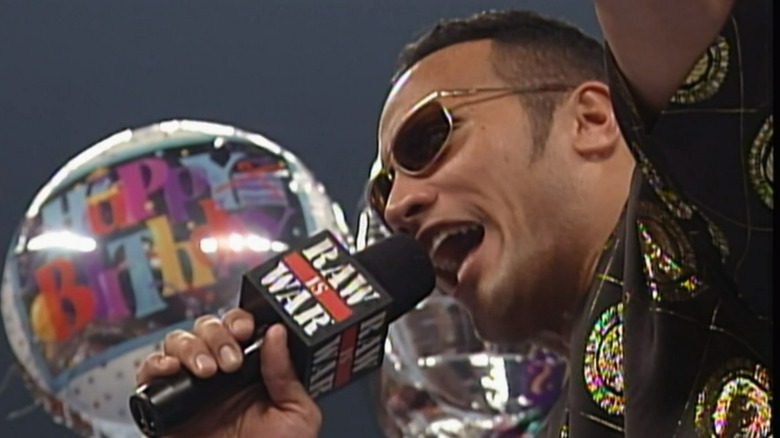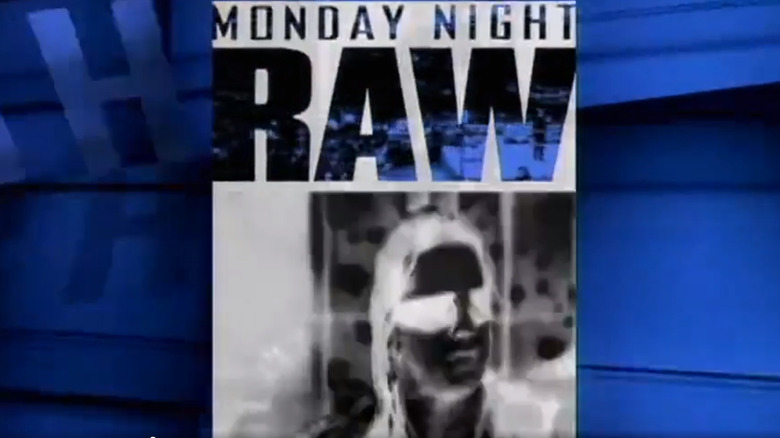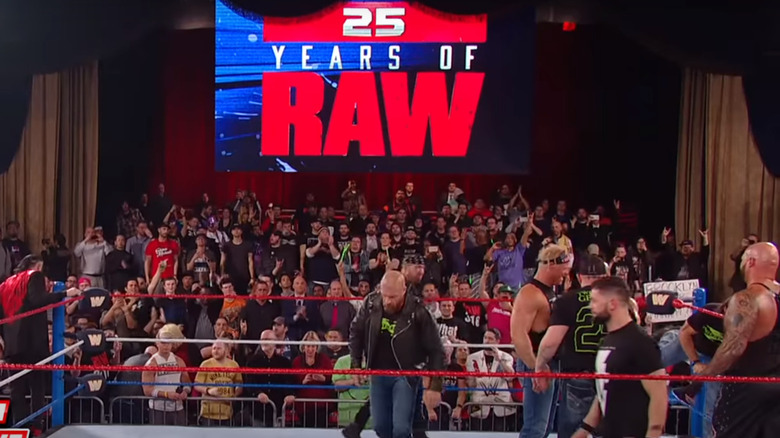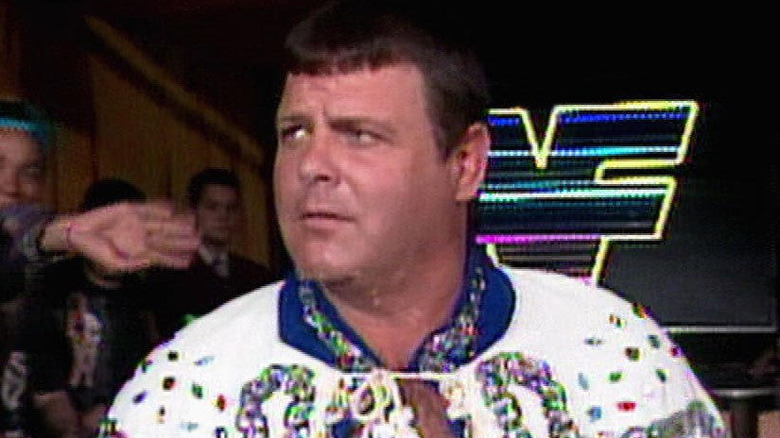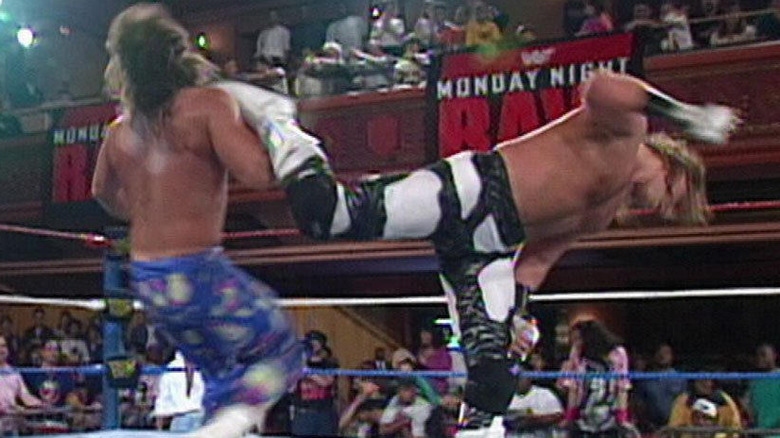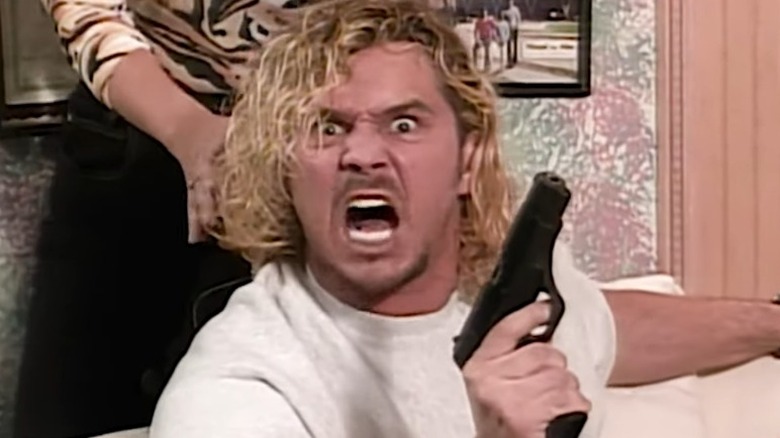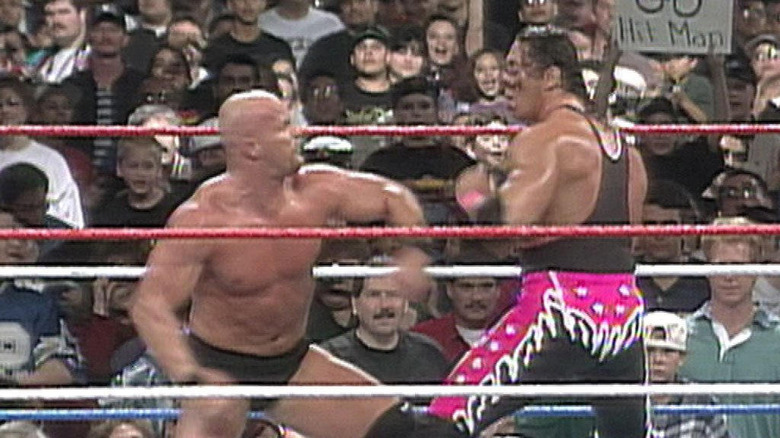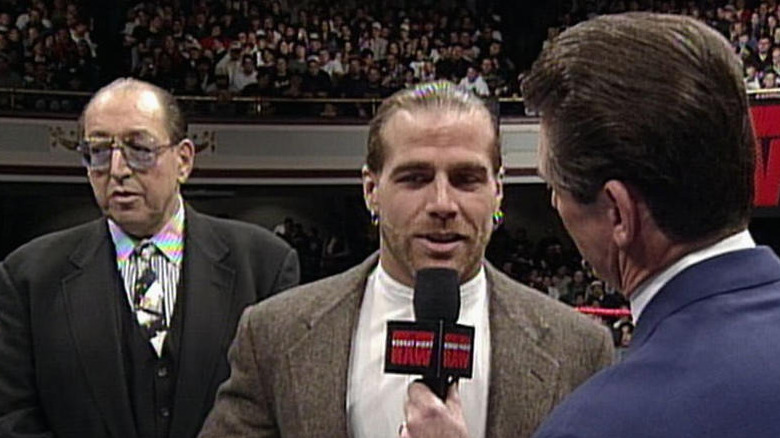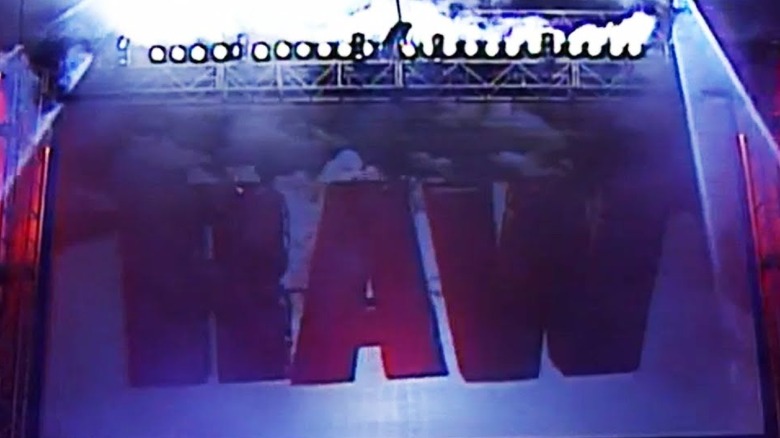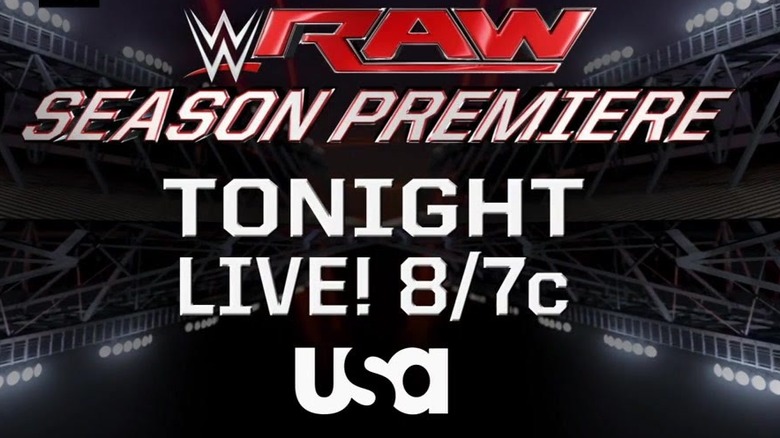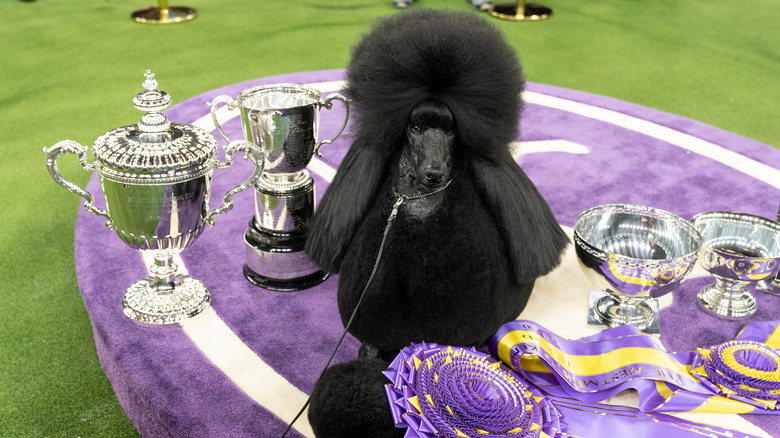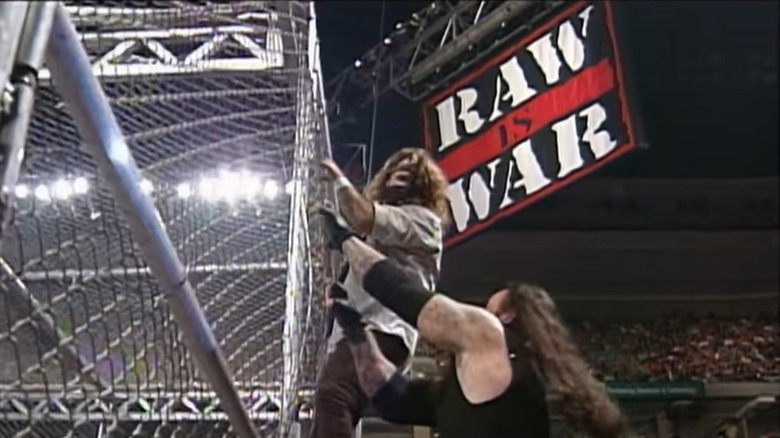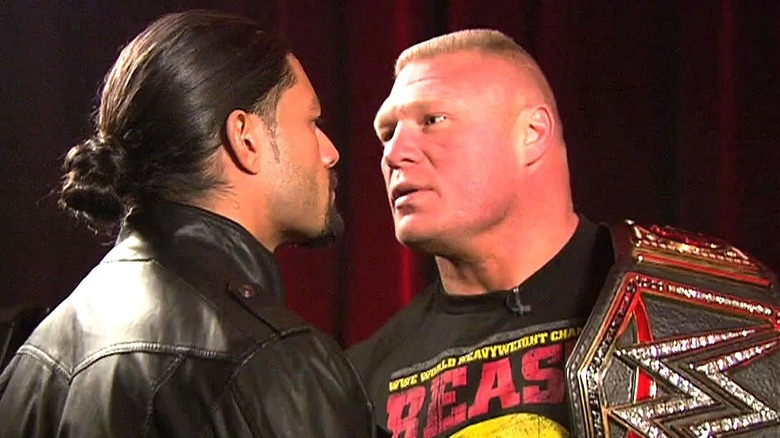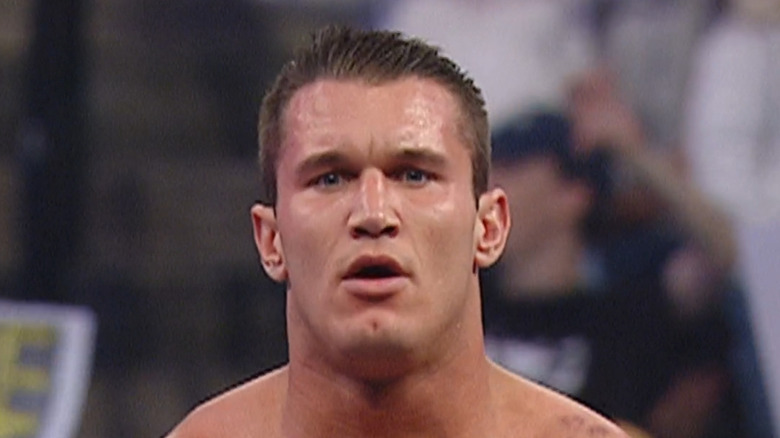Facts Only Hardcore Fans Know About WWE Raw
Three things are certain in this world: death, taxes, and "Monday Night Raw" airing on Monday nights. "Raw" is oftentimes dubbed "the longest running weekly episodic television show in history," which has some pieces of truth with a few weasel words mixed in. "Monday Night Raw," as WWE themselves note, does indeed have the most episodes for a show that runs live on a weekly basis, clocking in at over 1,500 episodes. That being said, there are shows that have been on the air for more years, such as "The Simpsons." The difference is, these shows have not produced new episodes on a weekly basis all year long.
Throughout the years, WWE has added and dropped programming in their weekly line-up, but "Monday Night Raw" has been a staple since it started in January of 1993. A lot has happened throughout that monstrous amount of programming and "Raw" has gone through changes to its appearance, the way in which storylines are presented, and the talent that is featured weekly. "Monday Night Raw" has given fans many memorable matches, feuds, and segments, but there are many pieces about the history of "Raw" that's often forgotten about.
The name Raw was derived from a feeling
Wrestling show names are always ones that pack a punch and are easily marketable, such as, "Smackdown," "Nitro," "Dynamite," and many more. All these names are explosive in context, except "Raw" doesn't quite fit the bill. In fact, "Raw" originated more from the idea of what the WWF wanted "Monday Night Raw" to "feel" like. Bruce Prichard, who was Vince's right hand man at this time, said on the "Not Sam" podcast (h/t Ringside News) that WWF wanted a show that was grungy, dirty, and unpolished.
WWF wanted to show the audience that anything could happen, and the feeling that even those working on the show didn't know what was going to happen at any given moment. At one point the working name was "Down & Dirty," but the marketability of that was low. With some more wordsmithing and discussions about the look and vibe of the show, Vince McMahon and producers decided they wanted the show to feel "raw" and the rest is history. On January 11th, 1993, "Monday Night Raw" hit the airwaves as an uncut, uncooked, and uncensored broadcast.
Raw only emanated from the Manhattan Center at first
The first episode of "Monday Night Raw," and many episodes after, emanated from the beautiful Manhattan Center in New York City. Per PWI Insider, Vince McMahon had a grand vision for "Raw" where it would take place in an elegant setting, giving the show an "upscale" sort of vibe. However, the Manhattan Center did not last as a permanent venue, with some rumors suggesting that it was a nightmare for fans to get in and out of the building.
The "Raw" tapings took place on the eighth floor, giving over a thousand fans the choice to either take one of two elevators or run up eight flights of stairs. In addition, some wrestlers complained about the cost of relocating to New York City in order to complete sets of tapings. After leaving, WWE has returned to the Manhattan Center two other times since they originally left, once in 1997 and one more time in 2018 for the "Raw" 25th Anniversary special.
The first ever post-Wrestlemania Raw was nothing special
WrestleMania weekend is a majorly hyped time for both fans and media alike, and this hype has strengthened ever since WWE has made WrestleMania a two-night spectacle. The "Raw" immediately after WrestleMania has come into its own over the last decade as well. This episode of "Raw" always features a hot crowd, fallout from WrestleMania, and big debuts and surprises. However, the first "Raw" after WrestleMania — as recounted by Cageside Seats — was not even close to as exciting as it is now.
The first "Raw" after WrestleMania came after a lackluster WrestleMania IX show. This "Raw" took place on April 5th, 1993 and was actually filmed before WrestleMania IX. The most notable part was the "Raw" debut of Jerry "The King" Lawler. Lawler started as an announcer for WWF Superstars a year prior and had wrestled in the 1993 Royal Rumble along with the territories for years. However, this was the first time fans saw Lawler compete in the ring on "Raw." He faced Jim Powers and walked out of the match twice due to fans chanting "Burger King" at him. Watching this "Raw" will make any fan appreciate what the "Raw" after WrestleMania has become.
The first title change happened early on
Championship title changes are not always commonplace on "Monday Night Raw." Usually reserved for pay-per-view matches, a title change on "Raw" can make an episode historic. In May of 1993, "Raw" had been on the air for about 4 months. On the May 13th episode of "Monday Night Raw" that year, Shawn Michaels (the Intercontinental Champion at the time) faced his long time tag team partner, Marty Jannetty. Jannetty defeated Michaels to capture the Intercontinental Championship, and although his title reign only lasted 20 days, this title change helped boost the credibility of "Raw" as a major player on Monday nights.
The first World Championship title change didn't come until February 17, 1997, when Sycho Sid defeated Bret Hart for the belt. The most prominent change happened on December 29th, 1998, which aired the following week. The main event of this pre-taped episode of "Raw" saw The Rock vs. Mankind with the WWF Title on the line. Mankind had garnered quite a bit of fan attention at this time and in a huge upset, he defeated The Rock to win his first WWF Championship. This episode of "Raw" certainly put some "butts in the seats".
The Brian Pillman & Stone Cold gun segment almost got the show canceled
One of the most infamous segments in "Raw" history happened during the heated feud between "Stone Cold" Steve Austin and Brian Pillman. This segment saw Steve Austin break into Pillman's house for a confrontation and Brian Pillman pull a gun on Stone Cold. A chaotic scene unfolds as Kevin Kelly (who was there to interview Pillman) tries to defuse the situation and Pillman's wife cries on the couch. "Raw" goes off the air as Pillman is still wildly pointing the gun. Vince McMahon's hope with this segment was to bring more realism to the product and begin to steer away from the cartoony feel of "Monday Night Raw."
However, as recounted by EWrestling, this segment was so authentic that many parents called USA Network to express their concerns about the violent content. Many advertisers were concerned as well. This led USA Network almost dropping "Monday Night Raw" from their programming line up. Once things cooled down, it was agreed within WWF management to tone down the content a bit and that the Austin/Pillman segment was too much.
Of course later down the line, WWF continued pushing boundaries when during the Attitude Era in earnest, despite the controversy that this segment produced. In addition, it was a launch pad into what would become the true "Stone Cold" Steve Austin character.
An episode of Raw showed the 1997 Royal Rumble (kind of)
The 1997 Royal Rumble match had a controversial ending as Steve Austin was declared the official winner. The problem was, Austin was actually eliminated earlier in the match, but referees had failed to catch his feet touching the ground. The ending of the match led to a lot of confusion and, to capitalize on this confusion, WWF marketed the January 27th, 1997 episode of "Raw" as "Royal Rumble Raw".
This was the first two hour broadcast of "Monday Night Raw" (per Sportskeeda) and many fans thought they were going to get to see the controversial Royal Rumble that had happened 24 hours prior. Unfortunately, all fans got was a filler card with some Royal Rumble match highlights sprinkled in. The problem was pay-per-view was a huge money maker in these days and there was no way Vince McMahon and cable providers alike were actually going to air the whole Royal Rumble match when there was pay-per-view replay money to be had.
There was a Thursday Night Raw
In 1997, the WWF and "Monday Night Raw" were constantly getting clobbered in ratings war against WCW "Nitro." The two shows would go head to head one the same night, at the same time slot. This made Vince McMahon wonder what would happen if "Raw" aired unopposed on a different night (per Cultured Vultures). This thought brought a unique "Thursday Night Raw" broadcast on February 13th, 1997, which actually turned out to be a huge episode.
The most notable piece of the show was when Shawn Michaels came out to tell fans he was relinquishing his WWF Championship because he had "lost his smile." What that means exactly is still up for interpretation, but at the time, the storyline was that Michaels had a career threatening knee injury. Regardless of the true meaning, this changed the trajectory for WrestleMania 13. In fact, it blew the door wide open for one of the biggest stars to come from wrestling, "Stone Cold" Steve Austin. From this unique "Raw" forward, Austin began feuding with Bret Hart, bringing them to a dramatic climax at WrestleMania 13, and an instant classic was born amidst a double turn. It raises the question, would this have ever happened if Shawn Michaels didn't "lose his smile" on "Thursday Night Raw"?
The highest rated episode of Raw drew an 8.1 rating
The highest rated episode of "Monday Night Raw" happened due to a stroke of luck for WWF and some misfortunes for WCW. The May 10th, 1999 episode of "Raw" drew an astounding 8.1 rating, following the trend of growing ratings for the WWF. This "Raw" was building toward a highly anticipated Over The Edge pay-per-view on the horizon.
There were a few things that garnered the 8.1 rating for the WWF (via Bleacher Report). First, WCW had been preempted by the NBA playoffs. so "Raw" ran unopposed that Monday Night. In addition, "Raw" stacked the card with a star studded main event. It saw the team of Steve Austin, The Rock, and Vince McMahon take on the team of Triple H, Undertaker, and Shane McMahon. This match was a combination of different rivalries coming together to make a TV match magic and the ratings reflected that.
Raw wasn't always on the USA Network
USA Network had been home to "Monday Night Raw" since it began on January 11th, 1993 all the way up until September 18th, 2000. Starting on September 25th, 2000 the "Raw" product jumped ship to be part of TNN/Spike TV and joined the Viacom family for five years. On October 3rd, 2005, "Raw" had a homecoming episode that aired on the USA Network for the first time in five years. There were some reports (via Sportskeeda) that over time that the USA Network regretted letting "Raw" go to Spike TV in hindsight.
On Episode 232 of "Something To Wrestle With," Bruce Prichard — who acted as the executive producer of "Raw" at the time — summarized their line of thinking at the time: "We're looking at NBC Universal as a whole, and the different partnerships that we have, and how we can utilize those and go through and the doors that opened up not just from one little USA Network in Monday Night RAW, across the board with theme parks, which we did partnerships with the Universal Theme Parks and did different things." Since this time, WWE has had a great relationship with USA Network and has aired weekly since. WWE has also dabbled in attractions at Universal Studios, including one called "The Undertaker: No Mercy" and the sale of wrestler-branded T-shirts at the park.
Raw used to get bumped due to the Westminster Dog Show
Airing on Monday in prime time has always been an identifying factor of the "Raw" brand, but that wasn't always the case when the Westminster Dog Show needed a slot on the USA Network. The Westminster Dog Show ran annually with (per Awful Announcing) night one airing on CNBC and night two airing on the USA Network, starting in 1984. Throughout the years, the two shows clashed a handful times causing Raw to have to move to a different night, such as "Saturday Night Raw" in 1999 (it still aired on Monday in Canada), or be pre-empted altogether like it was in 2006 (via Cageside Seats).
Sometimes WWE would put on alternative programming that happened before the dog show went live. In 2006, Torrie and her dog Chloe hosted "WWE: Best in Show" on WWE.com, looking back at WWE's coolest and craziest canine moments over the years. In 2017, "Raw" stopped being in danger of preemption, as the dog show began primarily airing on Fox Sports 1. It was always a strange occurrence to see a juggernaut of a show like "Monday Night Raw" get pushed out of the way by the Westminster Dog Show, but hey, those dogs need to win championships too.
Why Raw dropped the War in Raw is War
As the WWF moved to an edgier product during the Attitude Era, they also wanted an edgier name to "Raw," hence "Raw is War." In addition, the second half of "Raw" was called the "War Zone" to help freshen the show up as it went into the last hour. This idea of considering "Raw" a "warzone" started in 1997, just on the cusp of the Attitude Era.
The terrorist attacks of September 11th, 2001 changed WWF's thought on using "war" as a marketing tool for their weekly "Raw" broadcast. As talks of a "war on terror" began to grow, WWF brought their weekly Monday show back to just "Monday Night Raw" and also dropped the idea of the "War Zone" in the second hour (per TJRWrestling). Since then, we have not seen "Raw" get an official rebrand in this way, unless of course, we want to count "Raw" Underground or the short stint of "Raw" After Dark.
The Raw after Royal Rumble 2015 was postponed due to snow
The year is 2015. Roman Reigns is getting booed and fans are calling him "overrated." The negativity doesn't seem to matter because Roman Reigns wins the 2015 Royal Rumble to the anger of everyone at home and in the arena. Not even The Rock can save him with his promo skills. Now everyone wanted to know how WWE would do damage control and they wanted to hear the live audience reactions from the "Raw" crowd in Hartford, Connecticut.
However, mother nature also hated Roman Reigns and WWE's booking at the time, and a huge snow storm hit the New England area. The arena canceled "Raw" from happening live. WWE still had to fill three hours of programming on Monday night to uphold their contract with USA Network. The January 26th, 2015 episode of "Raw" was filled with a lot of backstage interviews emanating from WWE Headquarters, most notably one with Roman Reigns and then WWE Champion Brock Lesnar (via The Washington Post). In addition, WWE showed highlights and recaps from the Royal Rumble pay-per-view. Needless to say, it was a highly anticipated "Raw" that quickly became one of the most forgettable.
Which superstar holds the most Monday Night Raw appearences
One of the unique pieces of being the longest running weekly episodic television show in history is the fact that some characters stick around for the long haul. Similar to a soap opera, WWE has featured some wrestlers/characters hundreds of times on "Monday Night Raw." It's a fair guess that John Cena holds the record for the most appearances performed on "Raw" and at one point that was the case.
However, within the last couple years, Randy Orton has stolen that title from Cena, clocking in at over 450 appearances (at the time of writing). Orton was brought into WWE, quickly joined the Evolution stable in 2002, and later went on to become the youngest World Heavyweight Champion. With these early career accolades and Randy Orton's more recent appearances in the tag team RK-Bro, it makes sense that Orton was able to surpass John Cena in appearances. Other honorable mentions for this section are Kane at 442 appearances and Chris Jericho at 425 appearances.
